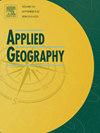Interplay between aridity changes and urban expansion across Chinese cities
IF 4
2区 地球科学
Q1 GEOGRAPHY
引用次数: 0
Abstract
Urban aridification has emerged as a significant challenge to the sustainable development of cities. Although China has experienced rapid urbanization and dryland expansion in recent decades, their relationship and potential challenges remains underexplored. To fill this gap, we conducted a national-scale analysis of spatiotemporal changes in dryland boundaries and urbanization patterns in Chinese cities between 1985 and 2022. Our findings reveal a significant eastward expansion of dryland boundaries beyond the Hu-Huanyong line, increasing the number of cities within dryland regions, particularly large urban agglomerations. Notably, urban growth in dryland areas has outpaced that in more humid regions, especially in cities located in the driest subtypes of these regions. Overall, a significant drying trend has been widely observed in about one-third of Chinese cities, impacting over 100 million people. These findings highlight the increasing vulnerability of urban populations to a drying climate, underscoring the need for climate-adaptive urban policies. Our results contribute to a deeper understanding of the interplay between urbanization and dryland expansion and offer critical insights for developing climate-resilient policies.
求助全文
约1分钟内获得全文
求助全文
来源期刊

Applied Geography
GEOGRAPHY-
CiteScore
8.00
自引率
2.00%
发文量
134
期刊介绍:
Applied Geography is a journal devoted to the publication of research which utilizes geographic approaches (human, physical, nature-society and GIScience) to resolve human problems that have a spatial dimension. These problems may be related to the assessment, management and allocation of the world physical and/or human resources. The underlying rationale of the journal is that only through a clear understanding of the relevant societal, physical, and coupled natural-humans systems can we resolve such problems. Papers are invited on any theme involving the application of geographical theory and methodology in the resolution of human problems.
 求助内容:
求助内容: 应助结果提醒方式:
应助结果提醒方式:


